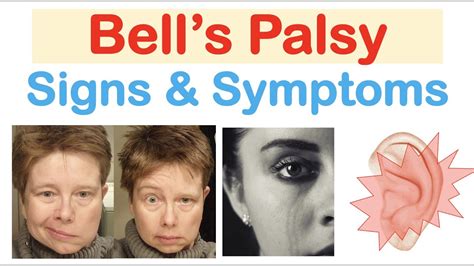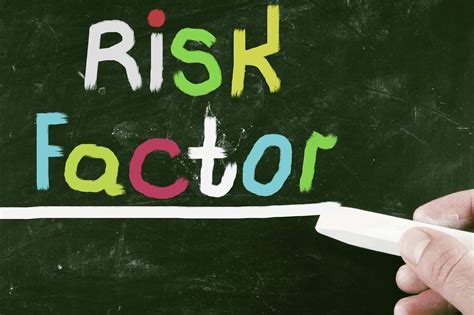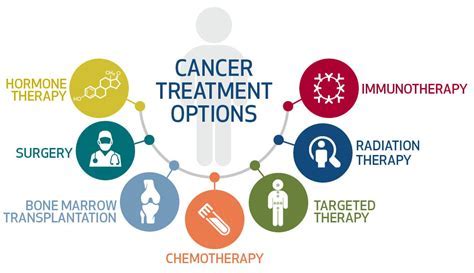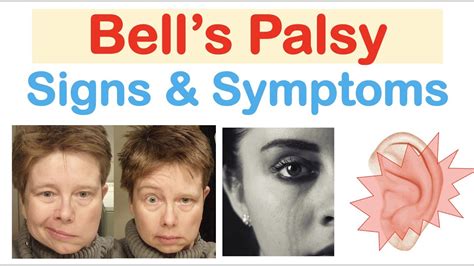Intro
Discover 7 key Bells Palsy symptoms, including facial weakness, drooping, and twitching, to identify this neurological condition, characterized by nerve damage, paralysis, and muscle spasms, affecting facial expressions and overall well-being.
Bell's palsy is a condition that affects the nerves in the face, causing a range of symptoms that can be distressing and disruptive to daily life. The condition is characterized by weakness or paralysis of the facial muscles, which can lead to difficulties with facial expressions, speech, and even vision. Understanding the symptoms of Bell's palsy is crucial for seeking medical attention and receiving appropriate treatment. In this article, we will delve into the common symptoms of Bell's palsy, exploring what they are, how they manifest, and what they might mean for those affected.
Bell's palsy can strike suddenly, often without warning, and its symptoms can vary from person to person. Some people might experience mild symptoms that resolve on their own within a few weeks, while others might face more severe symptoms that require medical intervention. The condition's impact on daily life should not be underestimated, as it can affect not only physical appearance and functionality but also emotional well-being and social interactions. By recognizing the symptoms of Bell's palsy, individuals can take the first step towards managing the condition and regaining control over their facial movements and expressions.
The symptoms of Bell's palsy can be quite pronounced, making it essential to understand what to look out for. These symptoms often include sudden weakness or paralysis of the facial muscles, drooping of the eyelid or corner of the mouth, difficulty speaking or forming words, and changes in taste. Additionally, some people might experience pain or numbness in the face, increased sensitivity to sound, or difficulty closing the eye on the affected side. These symptoms can be alarming, especially when they appear suddenly, but knowing what they are and how they relate to Bell's palsy can provide reassurance and guide the next steps towards recovery.
Introduction to Bell's Palsy Symptoms

Common Symptoms of Bell's Palsy
The common symptoms of Bell's palsy include: - Sudden weakness or paralysis of the facial muscles - Drooping of the eyelid or corner of the mouth - Difficulty speaking or forming words - Changes in taste - Pain or numbness in the face - Increased sensitivity to sound - Difficulty closing the eye on the affected side These symptoms can vary in severity and might develop rapidly over hours or days. Recognizing these symptoms is crucial for seeking medical attention, as early treatment can significantly improve outcomes.Causes and Risk Factors of Bell's Palsy

Risk Factors for Developing Bell's Palsy
Some of the key risk factors for developing Bell's palsy include: - Viral infections, such as herpes simplex or influenza - Diabetes - High blood pressure - Pregnancy, especially in the third trimester - Family history of Bell's palsy - Age, with most cases occurring between the ages of 15 and 45 Being aware of these risk factors can help individuals take preventive measures and be more vigilant for the symptoms of Bell's palsy.Treatment Options for Bell's Palsy

Steps in Managing Bell's Palsy
Managing Bell's palsy involves several steps, including: 1. **Seeking Medical Attention**: Early diagnosis and treatment are crucial for improving outcomes. 2. **Following a Treatment Plan**: Adhering to the prescribed treatment, whether it involves medication, physical therapy, or other interventions. 3. **Protecting the Eye**: Using eye drops or an eye patch to protect the eye on the affected side, especially if there's difficulty closing it. 4. **Maintaining a Healthy Lifestyle**: Eating a balanced diet, staying hydrated, and managing stress can help support recovery. 5. **Staying Informed**: Learning about Bell's palsy, its symptoms, causes, and treatment options can empower individuals to take an active role in their recovery.Living with Bell's Palsy

Coping Mechanisms for Bell's Palsy
Some effective coping mechanisms for Bell's palsy include: - **Staying Positive**: Focusing on the possibility of full recovery and the temporary nature of the condition. - **Seeking Support**: Connecting with family, friends, or support groups to share experiences and receive emotional support. - **Practicing Self-Care**: Engaging in activities that promote relaxation and stress reduction, such as meditation, yoga, or reading. - **Setting Realistic Goals**: Breaking down the recovery process into manageable goals and celebrating achievements along the way. - **Educating Oneself**: Learning about Bell's palsy to better understand the condition, its treatment, and what to expect during recovery.Conclusion and Next Steps

Final Thoughts on Bell's Palsy
Bell's palsy is a condition that affects not only the physical aspect of an individual's life but also their emotional and social well-being. However, with the right approach, support, and mindset, it is possible to manage the symptoms, undergo successful treatment, and emerge stronger and more resilient. Remember, seeking medical attention early, staying informed, and connecting with others who have experienced Bell's palsy can make a significant difference in the journey towards recovery.What are the primary symptoms of Bell's palsy?
+The primary symptoms of Bell's palsy include sudden weakness or paralysis of the facial muscles, drooping of the eyelid or corner of the mouth, difficulty speaking, and changes in taste. These symptoms can vary in severity and develop rapidly over hours or days.
How is Bell's palsy treated?
+Bell's palsy is treated based on the severity of the symptoms and the individual's overall health. Treatment options include corticosteroids to reduce inflammation, antiviral medications if the condition is caused by a viral infection, and physical therapy to help regain facial muscle strength and control.
Can Bell's palsy be prevented?
+While there is no guaranteed way to prevent Bell's palsy, understanding the risk factors and taking preventive measures can reduce the likelihood of developing the condition. This includes managing viral infections, controlling diabetes and high blood pressure, and maintaining a healthy lifestyle.
We hope this comprehensive guide to Bell's palsy symptoms has provided you with valuable insights and information. If you have any questions, comments, or personal experiences you'd like to share, please don't hesitate to reach out. Your input can help others better understand and cope with the condition. Remember, staying informed and connected is key to managing Bell's palsy and improving quality of life. Share this article with someone who might benefit from it, and let's work together to raise awareness and support for those affected by Bell's palsy.
